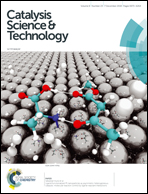Synthesis and physicochemical characterization of beta zeolite–bentonite composite materials for shaped catalysts†
Abstract
Composite materials for shaped catalysts were prepared from three commercial beta zeolites using bentonite as an aluminosilicate clay binder. All pristine materials and the synthesized powder mixtures were characterized using X-ray powder diffraction for phase purity and structures, scanning electron microscopy for morphology, transmission electron microscopy for porosity and periodicity, nitrogen physisorption for surface area, pore volume and pore size distribution, and Fourier transform infrared spectroscopy using pyridine as a probe molecule to elucidate the presence, strength and amount of Brønsted and Lewis acid sites. Elemental analysis was carried out using energy dispersive X-ray micro-analysis. Through a systematic comparison of the properties of the individual components and powder zeolite–binder composites, this study elucidated the crucial binder influence on the key properties of the catalytic supports during the synthesis of the composites in the powder form, i.e. prior to shaping. It can be concluded that the promoting effect of the bentonite binder is derived from chemical interactions with the zeolite. The resulting effect of the binder on the composite properties is not a simple additive just reflecting the nominal ratio of the components. The synthesis process, zeolite type (SiO2/Al2O3 ratio of the framework, particle size) and binder concentration play a significant role in the resulting binder effect in composites.



 Please wait while we load your content...
Please wait while we load your content...